The Two Wheeler Handlebars Market is estimated to be valued at USD 263.8 million in 2025 and is projected to reach USD 450.5 million by 2035, registering a compound annual growth rate (CAGR) of 5.5% over the forecast period.
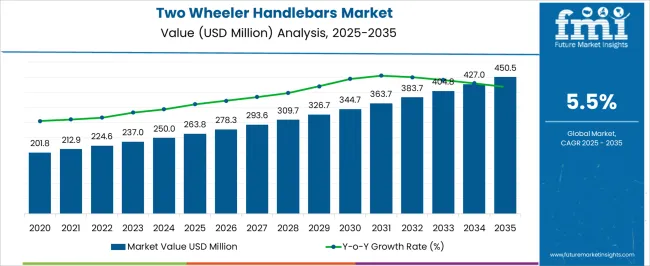
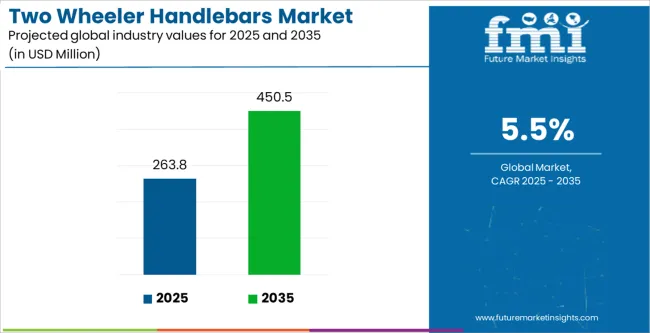
| Metric | Value |
|---|---|
| Two Wheeler Handlebars Market Estimated Value in (2025 E) | USD 263.8 million |
| Two Wheeler Handlebars Market Forecast Value in (2035 F) | USD 450.5 million |
| Forecast CAGR (2025 to 2035) | 5.5% |
The Two Wheeler Handlebars market is being driven by the increasing demand for motorcycles in urban and semi-urban regions, where mobility solutions are being sought to meet growing transportation needs. The market’s current growth is being supported by advancements in materials and manufacturing processes, which are improving product durability and reducing weight. Rising consumer preference for lightweight and corrosion-resistant components is further contributing to the market’s expansion.
The focus on enhancing riding comfort and safety is encouraging the development of ergonomically designed handlebars, which are widely used in commuter and performance motorcycles. Distribution networks are being enhanced through digital channels, providing greater access to aftermarket parts and enabling quick replacement and upgrades.
The future outlook is promising, as increased investment in two wheeler production, along with the rising trend of personal mobility, is expected to sustain demand The integration of handlebars with smart features and the growing popularity of electric two wheelers are also being seen as avenues for long-term growth, encouraging manufacturers to adopt new materials and improve distribution strategies.
The two wheeler handlebars market is segmented by type, material, distribution channel, sales channel, and geographic regions. By type, two wheeler handlebars market is divided into Motorcycles, Standard, Cruiser, Sports, Off-Road, Scooters, Maxi, and Enclosed. In terms of material, two wheeler handlebars market is classified into Steel, Aluminum, and Alloy. Based on distribution channel, two wheeler handlebars market is segmented into Online and Offline. By sales channel, two wheeler handlebars market is segmented into Original Equipment Manufacturers (OEMs) and Aftermarket. Regionally, the two wheeler handlebars industry is classified into North America, Latin America, Western Europe, Eastern Europe, Balkan & Baltic Countries, Russia & Belarus, Central Asia, East Asia, South Asia & Pacific, and the Middle East & Africa.
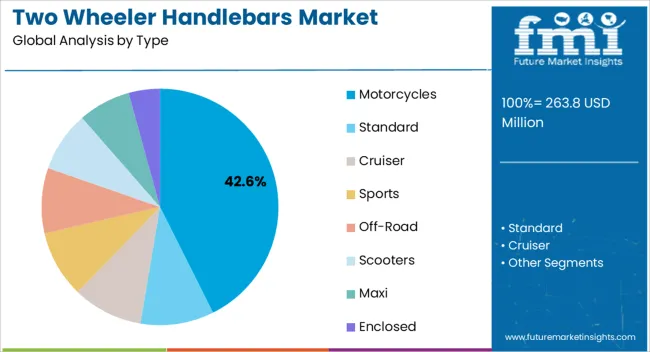
The motorcycle type is projected to account for 42.60% of the Two Wheeler Handlebars market revenue share in 2025, making it the leading type segment. This segment’s growth is being attributed to the increasing use of motorcycles as a primary mode of transportation in densely populated areas. Rising fuel prices and traffic congestion have led consumers to opt for cost-efficient and compact mobility solutions, which has directly contributed to the popularity of motorcycles.
The demand for better handling and improved safety in two wheelers has further propelled the need for advanced handlebars that can offer comfort and control during long rides. Manufacturers are responding by offering designs that enhance rider ergonomics and reduce vibration, thus increasing customer satisfaction.
The preference for motorcycles with customizable handlebars has also been observed, as riders are increasingly seeking improved aesthetics and performance features As urban infrastructure continues to support personal mobility and last-mile transportation, this segment is expected to maintain its lead, with further innovations in materials and design contributing to market expansion.
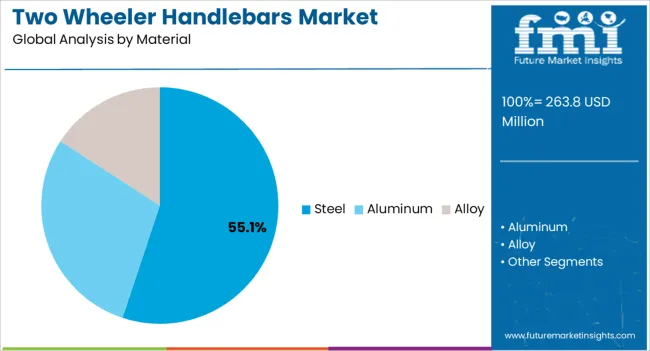
The steel material segment is expected to hold 55.10% of the Two Wheeler Handlebars market revenue share in 2025, establishing itself as the most preferred material category. This prominence is being driven by steel’s high strength, durability, and cost-effectiveness, making it a reliable choice for handlebars that are subjected to high stress and wear. Steel’s resistance to deformation under load ensures that handlebars provide stable control and safety, especially during high-speed riding or rough terrain use.
The material’s compatibility with various coatings and treatments has further enhanced its appeal, offering corrosion resistance and aesthetic customization options. Additionally, steel’s ease of fabrication and welding has allowed manufacturers to produce complex designs that meet the ergonomic needs of riders without significantly increasing production costs.
As two wheelers are increasingly used for both commuting and recreational purposes, the demand for handlebars that combine strength with affordability is being reinforced With manufacturers focusing on producing lightweight yet robust designs, steel is expected to remain the material of choice in this segment for the foreseeable future.
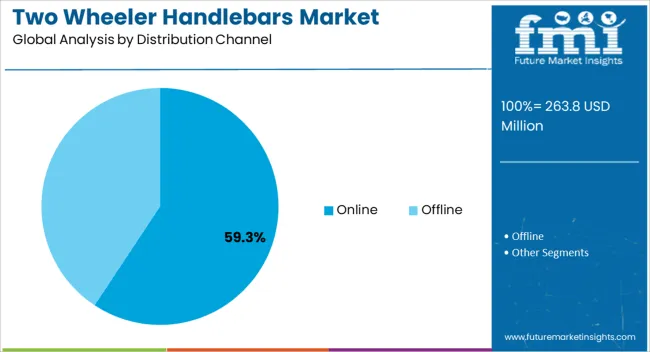
The online distribution channel is projected to account for 59.30% of the Two Wheeler Handlebars market revenue share in 2025, positioning it as the largest channel segment. This trend is being driven by the increasing adoption of e-commerce platforms that offer convenience, wider product selection, and competitive pricing. Consumers are being empowered to compare specifications, brands, and prices in real time, leading to more informed purchase decisions.
The availability of replacement parts, accessories, and customizable handlebars online has expanded the reach of manufacturers and enabled direct-to-consumer engagement, reducing reliance on traditional retail channels. Additionally, the rise of digital payment systems and faster delivery networks has reinforced consumer confidence in purchasing high-value products like handlebars online.
The pandemic-related disruptions to offline distribution networks accelerated the shift toward online sales, and this momentum has continued as consumers prefer contactless shopping experiences As manufacturers enhance their online presence and offer personalized product recommendations, the online distribution channel is being poised to lead growth, with future investments expected in user experience optimization, customer service, and digital marketing strategies.
Two wheeler handlebars are a part of the steering mechanism. These are rods that facilitate the driver in steering a vehicle/two wheeler. Handlebars are available in different sizes, shapes, and designs. Many accessories are integrated on handlebars such as light switch modules, break, clutch, and mirrors.
Nowadays, manufacturers are focusing on manufacturing lightweight and corrosion-resistant handlebars in order to improve steering stability as well as the performance of the vehicle/two wheeler. Two wheeler manufacturers are integrating handlebars on their vehicle that provide riding comfort to the rider.
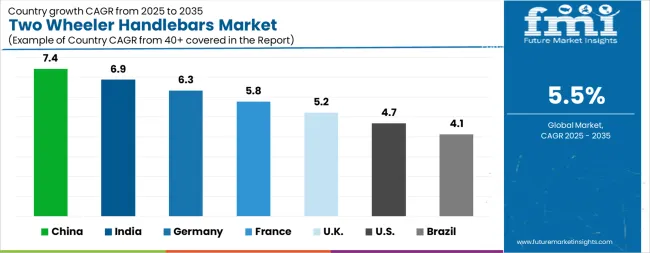
| Country | CAGR |
|---|---|
| China | 7.4% |
| India | 6.9% |
| Germany | 6.3% |
| France | 5.8% |
| UK | 5.2% |
| USA | 4.7% |
| Brazil | 4.1% |
The Two Wheeler Handlebars Market is expected to register a CAGR of 5.5% during the forecast period, exhibiting varied country level momentum. China leads with the highest CAGR of 7.4%, followed by India at 6.9%. Developed markets such as Germany, France, and the UK continue to expand steadily, while the USA is likely to grow at consistent rates. Brazil posts the lowest CAGR at 4.1%, yet still underscores a broadly positive trajectory for the global Two Wheeler Handlebars Market. In 2024, Germany held a dominant revenue in the Western Europe market and is expected to grow with a CAGR of 6.3%.
The USA Two Wheeler Handlebars Market is estimated to be valued at USD 94.8 million in 2025 and is anticipated to reach a valuation of USD 149.7 million by 2035. Sales are projected to rise at a CAGR of 4.7% over the forecast period between 2025 and 2035. While Japan and South Korea markets are estimated to be valued at USD 12.5 million and USD 7.1 million respectively in 2025.
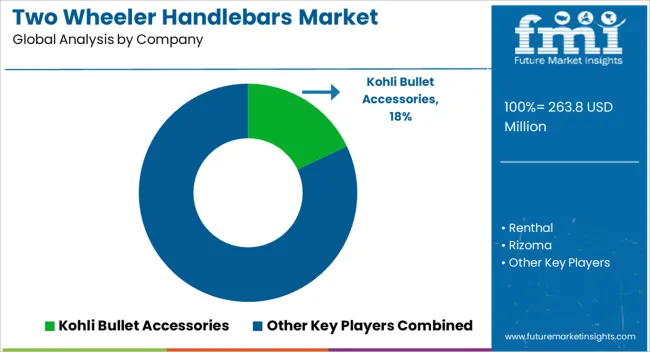
| Item | Value |
|---|---|
| Quantitative Units | USD 263.8 Million |
| Type | Motorcycles, Standard, Cruiser, Sports, Off-Road, Scooters, Maxi, and Enclosed |
| Material | Steel, Aluminum, and Alloy |
| Distribution Channel | Online and Offline |
| Sales Channel | Original Equipment Manufacturers (OEMs) and Aftermarket |
| Regions Covered | North America, Europe, Asia-Pacific, Latin America, Middle East & Africa |
| Country Covered | United States, Canada, Germany, France, United Kingdom, China, Japan, India, Brazil, South Africa |
| Key Companies Profiled | Kohli Bullet Accessories, Renthal, Rizoma, Flanders, Burleigh Bars, Lyon Lee Autotop Industry, Saler Wang Foshan Xinmatuo Motorcycle Parts Industrial, and Steel Thorn |
The global two wheeler handlebars market is estimated to be valued at USD 263.8 million in 2025.
The market size for the two wheeler handlebars market is projected to reach USD 450.5 million by 2035.
The two wheeler handlebars market is expected to grow at a 5.5% CAGR between 2025 and 2035.
The key product types in two wheeler handlebars market are motorcycles, standard, cruiser, sports, off-road, scooters, maxi and enclosed.
In terms of material, steel segment to command 55.1% share in the two wheeler handlebars market in 2025.






Our Research Products

The "Full Research Suite" delivers actionable market intel, deep dives on markets or technologies, so clients act faster, cut risk, and unlock growth.

The Leaderboard benchmarks and ranks top vendors, classifying them as Established Leaders, Leading Challengers, or Disruptors & Challengers.

Locates where complements amplify value and substitutes erode it, forecasting net impact by horizon

We deliver granular, decision-grade intel: market sizing, 5-year forecasts, pricing, adoption, usage, revenue, and operational KPIs—plus competitor tracking, regulation, and value chains—across 60 countries broadly.

Spot the shifts before they hit your P&L. We track inflection points, adoption curves, pricing moves, and ecosystem plays to show where demand is heading, why it is changing, and what to do next across high-growth markets and disruptive tech

Real-time reads of user behavior. We track shifting priorities, perceptions of today’s and next-gen services, and provider experience, then pace how fast tech moves from trial to adoption, blending buyer, consumer, and channel inputs with social signals (#WhySwitch, #UX).

Partner with our analyst team to build a custom report designed around your business priorities. From analysing market trends to assessing competitors or crafting bespoke datasets, we tailor insights to your needs.
Supplier Intelligence
Discovery & Profiling
Capacity & Footprint
Performance & Risk
Compliance & Governance
Commercial Readiness
Who Supplies Whom
Scorecards & Shortlists
Playbooks & Docs
Category Intelligence
Definition & Scope
Demand & Use Cases
Cost Drivers
Market Structure
Supply Chain Map
Trade & Policy
Operating Norms
Deliverables
Buyer Intelligence
Account Basics
Spend & Scope
Procurement Model
Vendor Requirements
Terms & Policies
Entry Strategy
Pain Points & Triggers
Outputs
Pricing Analysis
Benchmarks
Trends
Should-Cost
Indexation
Landed Cost
Commercial Terms
Deliverables
Brand Analysis
Positioning & Value Prop
Share & Presence
Customer Evidence
Go-to-Market
Digital & Reputation
Compliance & Trust
KPIs & Gaps
Outputs
Full Research Suite comprises of:
Market outlook & trends analysis
Interviews & case studies
Strategic recommendations
Vendor profiles & capabilities analysis
5-year forecasts
8 regions and 60+ country-level data splits
Market segment data splits
12 months of continuous data updates
DELIVERED AS:
PDF EXCEL ONLINE
Two-Wheeler Lubricants Market Size and Share Forecast Outlook 2025 to 2035
Two Wheeler Anti-lock Braking System Market Size and Share Forecast Outlook 2025 to 2035
Two Wheeler Rental Market Size and Share Forecast Outlook 2025 to 2035
Two-Wheeler Aftermarket Components & Consumables Market Size and Share Forecast Outlook 2025 to 2035
Two Wheeler Suspension System Market Size and Share Forecast Outlook 2025 to 2035
Two Wheeler Safety Solutions Market Size and Share Forecast Outlook 2025 to 2035
Two Wheeler Fuel Injection System Market Size and Share Forecast Outlook 2025 to 2035
Two Wheeler Crash Guard Market Size and Share Forecast Outlook 2025 to 2035
Two-Wheeler Lead Acid Batteries Market Analysis - Size, Share, and Forecast Outlook 2025 to 2035
Two Wheeler Accessories Aftermarket Growth - Trends & Forecast 2025 to 2035
Two Wheeler Crankshaft Market Growth – Trends & Forecast 2024-2034
Two Wheeler Backrest Market
Two Wheeler Electric Starter Magnet Market
Two Wheeler Chain Sprocket Kit Market
Two Wheeler Footrest Market
Two-wheeler ECU Market
Two Wheeler Fenders Market
Two Wheeler Seats Market
Two-wheeler Battery Market
Electric Two-Wheelers MRO Market: Optimizing Performance and Durability in the Electric Vehicle Age

Thank you!
You will receive an email from our Business Development Manager. Please be sure to check your SPAM/JUNK folder too.
Chat With
MaRIA